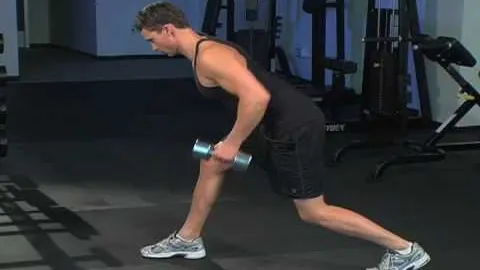
If you're looking to engage multiple muscle groups and improve your overall strength and stability, the hold lunge with dumbbell row exercise is a fantastic option. This compound movement targets the lower body, specifically the glutes, quads, and hamstrings, while also activating the upper back muscles through the dumbbell row. In this guide, we will break down the correct form, benefits, and variations of this exercise to help you get the most out of your workouts.
To perform the hold lunge with dumbbell row, follow these steps:
Starting position: Begin by holding a dumbbell in each hand, with your palms facing your body. Stand with your feet hip-width apart, and take a step forward with your right foot, keeping your back straight and your core engaged.
Lunge motion: Lower your body into a lunge position by bending your front knee at a 90-degree angle, making sure your knee doesn't extend past your toes. Simultaneously, let your back knee hover just above the ground. This will activate your leg muscles, particularly targeting the quads and glutes.
Dumbbell row: While maintaining the lunge position, start the dumbbell row motion by retracting your shoulder blades and pulling the dumbbells up towards your ribcage, squeezing your upper back muscles. Ensure that your elbows are kept close to your body throughout the movement.
Return to starting position: Slowly lower the dumbbells back down to the starting position, while simultaneously pushing through your front heel to stand back up. Reset your feet to hip-width apart and repeat the exercise on the other side.
The hold lunge with dumbbell row offers a range of benefits, making it a valuable addition to your workout routine:
Muscle activation: This exercise engages multiple muscle groups simultaneously, working your lower body, back, and core. Strong glutes, quads, and hamstrings are vital for overall lower body strength and stability.
Enhanced balance and stability: Performing a lunge while holding dumbbells challenges your balance and stability, improving coordination and proprioception. This exercise helps build stability in your core and lower body, reducing the risk of falls and injuries.
Upper back strength: The dumbbell row component of this exercise develops strength and stability in your upper back muscles, such as the rhomboids, trapezius, and rear deltoids. This can improve your posture and enhance your overall upper body strength.
Time efficient: The hold lunge with dumbbell row is a compound exercise that targets several muscle groups simultaneously. By incorporating this exercise into your routine, you can effectively maximize your workout time and efficiency.
Once you have mastered the basic hold lunge with dumbbell row, you can explore a few variations to keep challenging your muscles and progressing in your fitness journey:
Reverse hold lunge with dumbbell row: Instead of stepping forward, you can step backward into a lunge position. This variation places more emphasis on the glutes and hamstrings, providing a different stimulus to your muscles.
Single-arm dumbbell row lunge: Perform the hold lunge with only one dumbbell at a time, alternating between sides. This modification requires additional core engagement for stability and can help identify and correct muscle imbalances.
Raised heel hold lunge with dumbbell row: Place your front foot on an elevated surface, such as a small step or weight plate. This variation increases the range of motion and further activates your quads and glutes.
To ensure a safe and effective hold lunge with dumbbell row exercise, keep the following tips in mind:
Start with lighter weights: Beginners should start with lighter dumbbells and focus on mastering the proper technique before progressing to heavier weights. This will minimize the risk of injury and allow for a more controlled movement.
Maintain good posture: Throughout the exercise, maintain a neutral spine and avoid rounding or arching your back. This ensures proper muscle activation and reduces stress on your lower back.
Avoid excessive knee flexion: Ensure that your front knee stays aligned with your ankle and does not collapse inward. This reduces the risk of knee injuries and ensures optimal muscle engagement.
Choose appropriate dumbbell weight: Select a weight that challenges you while still allowing for proper form. If you are struggling to maintain proper technique or experience excessive fatigue, consider using lighter dumbbells.
In conclusion, the hold lunge with dumbbell row is a highly effective and efficient compound exercise that targets multiple muscle groups simultaneously. By incorporating this exercise into your routine, you can enhance your lower body strength, improve balance and stability, and strengthen your upper back muscles. Remember to focus on proper form, personalize the exercise to your fitness level, and prioritize safety at all times. Start slowly, practice consistently, and enjoy the transformative benefits this exercise has to offer!
If you're looking for a gym, fitness club or yoga studio, you've come to the right place.
You can find information about gyms in your area. Browse catalog of gyms and find gyms with classes which are you looking for.
On gym page you can find simple information like address, phone or website. You can find list of available classes. You can check availability of personal training or small group classes. On place page you can also see information about open hours.
You can find gyms near you with amenities, courts, studios and equipments.
Use our map to find gym at your city or district.
In Gym Navigator you can find list of exercises with movies for many body parts.
You can browse exercises catalog and find exercises the best of you.
You can also find exercises grouped into workout plans, which you can use to improve you body. Each routine show you exercises one by one and give you possibility to count you progress and count down rest time.